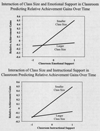Observations of Effective Teacher-Student Interactions in Secondary School Classrooms: Predicting Student Achievement With the Classroom Assessment Scoring System-Secondary
- PMID: 28931966
- PMCID: PMC5602545
Observations of Effective Teacher-Student Interactions in Secondary School Classrooms: Predicting Student Achievement With the Classroom Assessment Scoring System-Secondary
Abstract
Multilevel modeling techniques were used with a sample of 643 students enrolled in 37 secondary school classrooms to predict future student achievement (controlling for baseline achievement) from observed teacher interactions with students in the classroom, coded using the Classroom Assessment Scoring System-Secondary. After accounting for prior year test performance, qualities of teacher interactions with students predicted student performance on end-of-year standardized achievement tests. Classrooms characterized by a positive emotional climate, with sensitivity to adolescent needs and perspectives, use of diverse and engaging instructional learning formats, and a focus on analysis and problem solving were associated with higher levels of student achievement. Effects of higher quality teacher-student interactions were greatest in classrooms with fewer students. Implications for teacher performance assessment and teacher effects on achievement are discussed.
Figures
Similar articles
-
Teaching Through Interactions in Secondary School Classrooms: Revisiting the Factor Structure and Practical Application of the Classroom Assessment Scoring System-Secondary.J Early Adolesc. 2015 Jun;35(5-6):651-680. doi: 10.1177/0272431614537117. Epub 2014 Jun 9. J Early Adolesc. 2015. PMID: 28232770 Free PMC article.
-
Interactional quality in middle schools: Latent profiles and their associations with teacher, classroom, and school compositional factors.J Sch Psychol. 2022 Aug;93:79-97. doi: 10.1016/j.jsp.2022.06.001. Epub 2022 Jul 15. J Sch Psychol. 2022. PMID: 35934452 Free PMC article.
-
Teacher-student interaction and lower secondary school students' situational engagement.Br J Educ Psychol. 2019 Jun;89(2):374-392. doi: 10.1111/bjep.12244. Epub 2018 Sep 3. Br J Educ Psychol. 2019. PMID: 30252125
-
Fostering Students' Autonomy and Engagement in EFL Classroom Through Proximal Classroom Factors: Autonomy-Supportive Behaviors and Student-Teacher Relationships.Front Psychol. 2021 Oct 20;12:767079. doi: 10.3389/fpsyg.2021.767079. eCollection 2021. Front Psychol. 2021. PMID: 34744946 Free PMC article. Review.
-
The Effect of Teacher Caring Behavior and Teacher Praise on Students' Engagement in EFL Classrooms.Front Psychol. 2021 Sep 14;12:746871. doi: 10.3389/fpsyg.2021.746871. eCollection 2021. Front Psychol. 2021. PMID: 34594287 Free PMC article. Review.
Cited by
-
Homeschooling during the SARS-CoV-2 pandemic: the role of students' trait self-regulation and task attributes of daily learning tasks for students' daily self-regulation.Z Erziehwiss. 2021;24(2):367-391. doi: 10.1007/s11618-021-01011-w. Epub 2021 Apr 1. Z Erziehwiss. 2021. PMID: 33821144 Free PMC article.
-
Development and Validation of an Unethical Professional Behavior Tendencies Scale for Student Teachers.Front Psychol. 2021 Dec 2;12:770681. doi: 10.3389/fpsyg.2021.770681. eCollection 2021. Front Psychol. 2021. PMID: 34925172 Free PMC article.
-
Optimization: In-Depth Examination and Proposition.Front Psychol. 2019 Jun 19;10:1398. doi: 10.3389/fpsyg.2019.01398. eCollection 2019. Front Psychol. 2019. PMID: 31275210 Free PMC article. Review.
-
Emotions as Both a Tool and a Liability: A Phenomenology of Urban Charter School Teachers' Emotions.Urban Rev. 2022 Dec 1:1-27. doi: 10.1007/s11256-022-00649-y. Online ahead of print. Urban Rev. 2022. PMID: 36471675 Free PMC article.
-
Effects of a Teacher Professional Development Intervention on Peer Relationships in Secondary Classrooms.School Psych Rev. 2011;40(3):367-385. School Psych Rev. 2011. PMID: 22736890 Free PMC article.
References
-
- Ainsworth MDS, Blehar MC, Waters E, Wall S. Patterns of attachment: A psychological study of the strange situation. Hillsdale, NJ: Erlbaum; 1978.
-
- Allen JP, Kuperminc G, Philliber S, Herre K. Programmatic prevention of adolescent problem behaviors: The role of autonomy, relatedness, and volunteer service in the Teen Outreach Program. American Journal of Community Psychology. 1994;22:617–638. - PubMed
-
- Bell KL, Allen JP, Hauser ST, O’Connor TG. Family factors and young adult transitions: Educational attainment and occupational prestige. In: Graber JA, Brooks-Gunn J, editors. Transitions through adolescence: Interpersonal domains and context. Mahwah, NJ: Erlbaum; 1996. pp. 345–366.
-
- Bill and Melinda Gates Foundation. Working with teachers to develop fair and reliable measures of effective teaching. 2010 Available online at http://www.metproject.org/downloads/met-framing-paper.pdf.
Grants and funding
LinkOut - more resources
Full Text Sources


